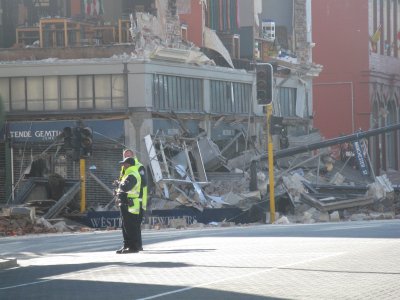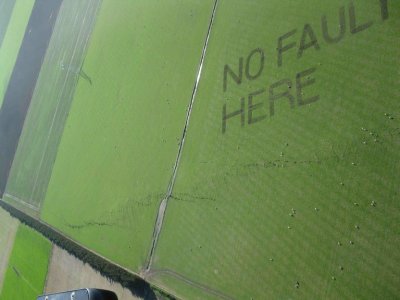EOSC 256: Earthquakes
Spring 2011
Instructor: Elizabeth H. Hearn (355 EOS South) ehearn@eos.ubc.ca


photos: Mark Quigley (2010 M 7.1 Canterbury NZ earthquake)


| W January 4 |
Course intro and survey, Mercalli intensity |
PDF |
Pre-course survey. |
| F January 6 |
Mercalli intensity and in-class activity. |
In-class activity 1: Intensity. |
|
| M January 9 |
Early earthquake
hypotheses (through 1906). |
PDF |
|
| W January 11 |
Faults as the
cause of earthquakes - old and modern evidence. First intro
to elastic rebound theory. |
PDF |
Assign Homework
1. |
| F January 13 |
NO CLASS |
NO CLASS. |
|
| M January 16 |
Types of faults,
Describing fault geometry and slip: strike, dip, rake, slip vector. |
PDF |
|
| W January 18 |
Field and other
observations of faults; Relationship between fault types and plate
tectonics. |
PDF |
Homework 1 is
due. |
| F January 20 |
In-class activity
2: Geometry of faults and slip. |
||
| M January 23 |
Types of seismic
waves, seismograms |
PDF |
|
| W January 25 |
Seismograms,
seismometers, sensitivity |
PDF |
|
| F January 27 |
In-class activity
3: seismometry (part of HWK 2) Assign Homework 2. |
||
| M January 30 |
Seismic networks,
locating earthquakes, early warning. |
PDF |
(Topic may go
into Wednesday) |
| W February 1 |
Earthquake magnitude. |
PDF |
|
| F February 3 |
In-class activity
4: Magnitude and location. |
||
| M February 6 |
Focal mechanisms,
why they matter (bombs, plate tectonics) I |
PDF |
|
| W February 8 |
Focal mechanisms,
why they matter (bombs, plate tectonics) II |
Homework 2 is due. |
|
| F February 10 |
In-class activity 5: Focal Mechanisms. |
||
| M February 13 |
How often, how big: Gutenberg-Richter magnitude-frequency
relationship, Omori's Law (I) |
PDF |
|
| W February 15 |
Scaling, characteristic earthquakes, review. |
||
| F February 17 |
MIDTERM EXAM |
STUDY GUIDE AND SAMPLE QUESTIONS |
|
| M February 27 |
Intro to earthquake
mechanics part of the course (next 3 weeks); displacement gradient matrix |
PDF |
|
| W February 29 |
Strain |
PDF |
|
| F March 2 |
(finish strain lecture, plus
activity) |
In-class activity 6: Strain
and rotation exercise (2D) |
|
| M March 5 |
Stress and elasticity |
PDF |
|
| W March 7 |
Stress and elasticity, Coulomb
failure criterion |
PDF |
|
| F March 9 |
In-class activity 7: Elastic
properties and seismic wave velocity from strain and density measurements. Assign Homework 3 (Saturday) |
||
| M March 12 |
Friction |
PDF |
|
| W March 14 |
Friction and instability;
generating an earthquake. |
PDF |
|
| F March 16 |
Extra-important in-class
activity 8: Spring-slider earthquake model. Homework 3 is due. |
||
| M March 19 |
Instability summary |
PDF |
Homework 3 is due. |
| W March 21 |
Conditions for large quakes |
PDF |
|
| F March 23 |
In-class activity 9: earthquake
triggering Assign Homework 4 |
||
| M March 26 |
Pore pressure changes and
triggering earthquakes |
PDF |
|
| W March 28 |
Earthquake triggering |
PDF |
|
| F March 30 |
PDF |
In-class activity 10: Human-induved
seismicity |
|
| M April 2 |
Forecasting earthquakes |
PDF |
|
| W April 4 |
Tsunamis |
PDF |
Homework 4 is due. |
| Final exam study guide TBA |